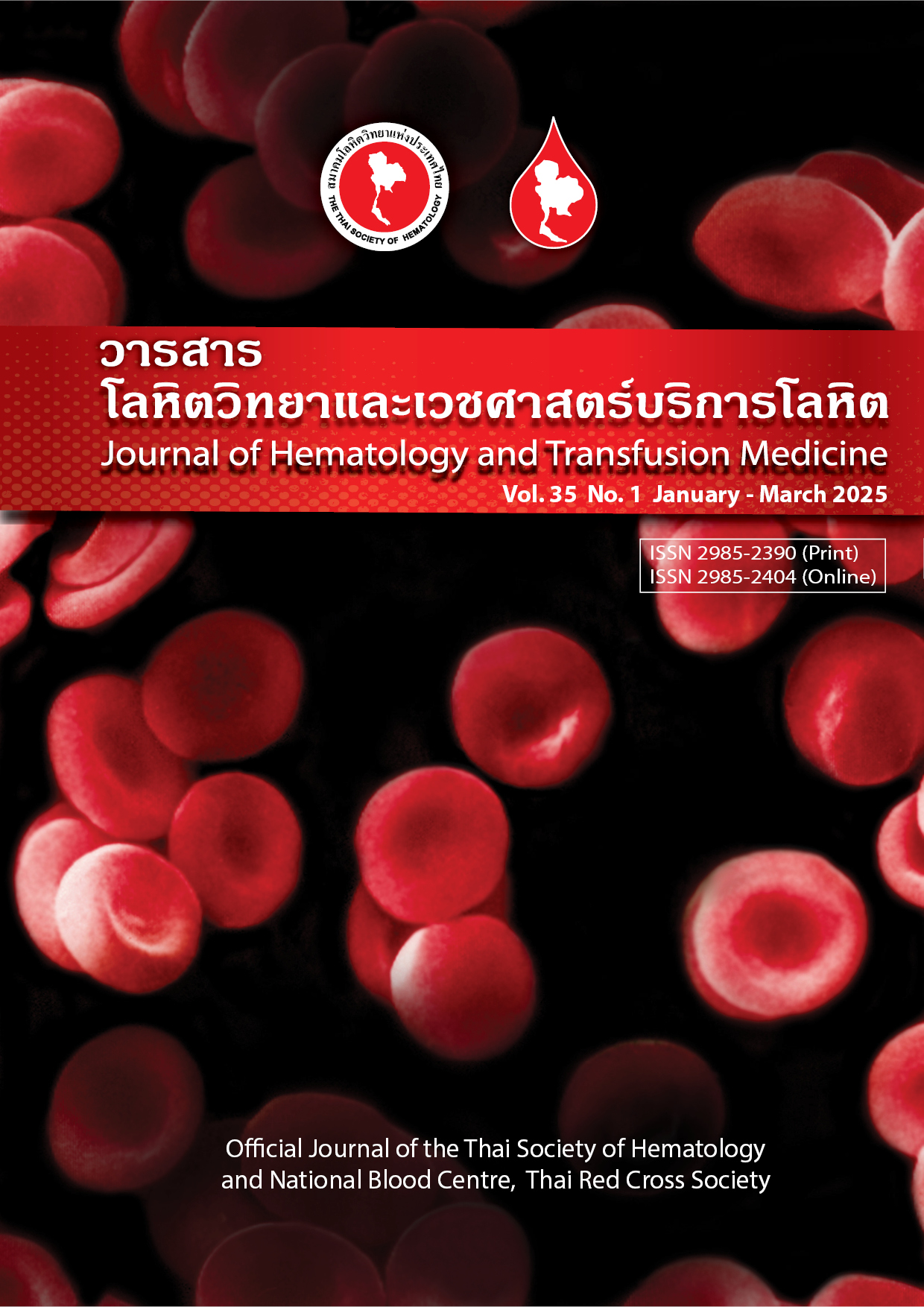The first Thai patient had a blood group allele that was CD36 heterozygous
Keywords:
CD36 deficiency, New blood group system, Next-generation sequencing, ภาวะพร่อง CD36, หมู่เลือดบนเม็ดเลือดแดงระบบใหม่Abstract
Abstract:
Introduction: CD36, or Naka (GPIV), is a glycoprotein found on platelet membranes and other cells, such as megakaryocytes, monocytes, endothelial cells, and adipocytes. It is also expressed at low levels in reticulocytes. In June 2023, the ISBT Working Party of Red Cell Immunogenetics and Blood Group Terminology (WP-RCIBGT) established CD36 as a new blood group system. Objective: To investigate the red blood cell (RBC) antibody, phenotype, and genotype in a thalassemia patient who required blood transfusion but could not find compatible blood that may be related to the CD36 new blood group. Materials and Methods: The conventional tube test (CTT) and column agglutination test (CAT) monitored red blood cell phenotype and antibody investigation. The Immucor BioArray HEA Precise BeadChipTM Kit performed genetic analyses. Next-generation sequencing (NGS) was performed using the Illumina DNA Prep with Enrichment Kit to identify variants relative to the reference sequence. The platelet antibody was performed to confirm anti-CD36 by monoclonal antibody-specific immobilization of platelet antigens (MAIPA). Results: The antibody investigation showed anti-E, -c, -Jka, -unidentified with cold autoantibody. Interestingly, the NGS result showed gene variation in CD36 (CD36) nucleotide substitution (c.380C>T), which leads to the missense amino acid (p.[Ser127Leu]) in the CD36 blood group protein. These changes were found in 191 of 409 DNA sequence reads, which are consistent with heterozygosity for c.380C>T. Conclusion: The new finding is that CD36 is at a heterozygous level (c.380C>T) in Thai patient. The autoantibody caused the incompatible crossmatch, not a high titer low avidity (HTLA)-related antibody.
บทคัดย่อ
บทนำ CD36 หรือ Naka เป็นไกลโคโปรตีนที่พบได้บนผิวเซลล์เกล็ดเลือด และเซลล์อื่นๆ เช่น เมกาคาริโอไซต์ โมโนโซต์ เซลล์เยื่อบุผนังหลอดเลือด เซลล์ไขมัน และพบการแสดงออกได้ต่ำๆ บนเม็ดเลือดแดงตัวอ่อน ในเดือนมิถุนายนปี ค.ศ. 2023 CD36 ได้รับการขึ้นทะเบียนเป็นหมู่เลือดใหม่จากคณะทำงาน ISBT Working Party of Red Cell Immunogenetics and Blood Group Terminology (WP-RCIBGT) การแสดงออกของ CD36 deficiency สามารถแบ่งออกได้ 2 กลุ่มคือ CD36 deficiency type I ที่ไม่มีการแสดงออกของ CD36 ทั้งบนผิวเกล็ดเลือด และโมโนไซต์ และ CD36 deficiency type II ที่ไม่มีการแสดงของ CD36 เฉพาะบนเกล็ดเลือด วัตถุประสงค์ เพื่อจัดหาเลือดที่เหมาะสมและปลอดภัยให้กับผู้ป่วยธาลัสซีเมีย วัสดุและวิธีการ การทดสอบหาแอนติบอดี และแอนติเจนบนผิวเม็ดเลือดแดงใช้เทคนิค CTT และ CAT ในส่วนการทดสอบทางลักษณะพันธุกรรม HEA ใช้ชุด Kit Immucor BioArray HEA Precise และตรวจหาลำดับเบสทางพันธุกรรมโดยใช้เทคนิค next-generation sequencing และทดสอบหาแอนติบอดีต่อแอนติเจนของเกล็ดเลือดด้วยเทคนิค monoclonal antibody-specific immobilization of platelet antigens (MAIPA) ผลการศึกษา พบว่าผู้ป่วยมีการสร้างแอนติบอดีต่อแอนติเจนของเม็ดเลือดแดงคือ anti-E-, -c, -Jka, -unidentified และ cold antibody จากการตรวจลำดับเบสของสารพันธุกรรมด้วยเทคนิค next-generation sequencing พบว่ามีการเปลี่ยนแปลงลำดับเบส ของหมู่เลือด CD36 (c.380C>T) ซึ่งนำไปสู่การเปลี่ยนแปลงกรดอะมิโน ทำให้หมู่เลือด CD36 มีการแสดงออกในรูปแบบ heterozygous สรุป จากการศึกษาพบว่า การที่ผู้ป่วยมีผลการตรวจความเข้ากันได้กับเลือดผู้บริจาคให้ผล incompatible อาจเกิดจาก autoantibody เท่านั้น ไม่ได้เกี่ยวข้องกับแอนติบอดีในกลุ่ม HTLA และจากการตรวจลำดับเบสของสารพันธุกรรม ทำให้พบการแสดงออกของหมู่เลือด CD36 ในรูป heterozygous
Downloads
References
Alattar AG, Storry JR, Olsson ML. Evidence that CD36 is expressed on red blood cells and constitutes a novel blood group system of clinical importance. Vox Sang. 2024;119:496-504.
Phuangtham R, Sudwilai Y, Leelayuwat C, Romphruk A. The study of CD36 expression on platelets in Thai blood donors using flow cytometry. J Med Tech Phys Ther. 2018;30:244-52.
Curtis BR, Aster RH. Incidence of the Nak(a)-negative platelet phenotype in African Americans is similar to that of Asian. Transfusion. 1996;331-4.
Lee K, Godeau B, Fromont P, Plonquet A, Debili N, Bachir D, et al. CD36 deficiency is frequent and can cause platelet immunization in Africans. Transfusion. 1999;39:873-9.
Tomiyama Y, Take H, Ikeda H, Mitani T, Furubayashi T, Mizutani H, et al. Identification of the platelet-specific alloantigen, Naka , on platelet membrane glycoprotein IV. Blood. 1990;75: 684-7.
Xu X, Ye X, Xia W, Liu J, Ding H, Deng J, et al. Studies on CD36 deficiency in South China: two cases demonstrating the clinical impact of anti-CD36 antibodies. Thromb Haemost. 2013;110:1199-206.
Yamamoto N, Akamatsu N, Sakuraba H, Yamazaki H, Tonoue K. Platelet glycoprotein IV (CD36) deficiency is associated with the absence (type I) or the presence (type II) of glycoprotein IV on monocyte. Blood. 1994;83:392-7.
Bierling P, Godeau B, Fromont P, Bettaieb A, Debili N, el-Kassar N, et al. Posttransfusion purpura-like syndrome associated with CD36 (Naka) isoimmunization. Transfusion. 1995;35:77-82.
Kengkate M, Srisuddee A, Roekchai C, Chinbordee K, Phiancharoen S, Kupatawintu P, et al. The study of CD36 (Naka antigen) phenotype in platelet apheresis donors of the National Blood Centre, Thai Red Cross Society. J Hematol Transfus Med. 2017;27:111-6.
Fujino H, Ohta K, Taniue J, Nagao N, Hino M, Yamane T, et al. Primary refractoriness to platelet transfusion caused by Naka antibody alone. Vox Sang. 2001;81:42-4.
Kankirawatana S, Kupatawintu P, Juji T, Veerakul G, Ngerncham S, Chongkulwatana V, et al. Neonatal alloimmune thrombocytopenia due to anti- Naka. Transfusion. 2001;41 375-7.
Xu X, Li L, Xia W, Ding H, Chen D, Liu J, et al. Successful management of a hydropic fetus with severe anemia and thrombocytopenia caused by anti-CD36 antibody. Int J Hematol. 2018;107:251-6.
Xu X, Santoso S. A narrative review on progress and development of anti-CD36 antibody detection. Ann Blood. 2021;6:35-9.
Okajima S, Cho K, Chiba H, Azuma H, Mochizuki T, Yamaguchi M, et al. Two sibling cases of hydrops fetalis due to alloimmune anti-CD36 (Naka) antibody. Thromb Haemost. 2006;95:267-71.
Lopez GH, Emthip M, Suwanwootichai P, Millard GM, Wilson B, Onpuns S, et al. Hemolytic disease of the fetus and newborn caused by anti-sD antibody in a GP.Mur/Mur Thai mother and review of the prevalence of s D in Thai blood donors. Transfusion. 2022;62:2137–42.
Canals JG C, I Vinyets M, Gracia NB, Cano V, Nogués N, MunizDiaz E. A case of neonatal thrombocytopenia due to isoantibodies against CD36: could these antibodies be the cause of red blood cell agglutination? (abstract). Vox Sang. 2020;115:58.
Downloads
Published
Issue
Section
License
Copyright (c) 2025 Journal of Hematology and Transfusion Medicine

This work is licensed under a Creative Commons Attribution-NonCommercial-NoDerivatives 4.0 International License.


